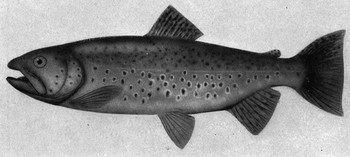How to Catch and Cook Trout
For daily wit & wisdom, sign up for the Almanac newsletter.
Body
Tips for Catching Trout
-
Never fish with the Sun behind you. Trout have excellent eyesight; if you cast shadows on the water, the trout will see you and swim away.
-
Be quiet when approaching your fishing spot. Trout also have excellent hearing. Moving through brush won't alert them, but unnatural noises (like clanging or banging) will.
-
Toss a chip of tree bark upstream before casting. Watch it to see if it swirls into an eddy or is diverted toward a little pool. If it does, that is where the fish will be hiding. Cast your lure and let it follow the chip's path.
-
Wear dark clothes. Trout can detect bright colors above them.
-
Use the thinnest possible leaders and line. Trout can see anything that isn't fine or transparent.
-
Night crawlers and other worms are the best bait. Keep your garden soil moist and turn it often to attract worms. Mix in fine compost and coffee grounds, if available.
Techniques for Cooking Trout
Try to clean a trout as soon as you catch it. Cut the belly open with a sharp, thin blade. Pull out the intestinal matter and put it in a bag for disposal later. (Putting it in a bag prevents flies). Dip a toothbrush in vinegar and scrub the fish inside and out.
If you're not at home, moisten some ferns or creek-side grass in cold water and pack the fish in them. Remoisten the plants periodically to keep the fish cool. If snow is available, pack the fish in it.
Plank Trout
-
Attach a trout, skin side down, to a smooth pine, fir, oak, or mesquite board. Drive one nail just behind the gill and another at the base of the tail. (Don't nail the flesh; it will develop a metallic taste.)
-
Prop the plank close to a fire. While it cooks, rub it with a piece of dropping-hot salt pork to keep it moist.
-
Stick the fish with a fork; if it slides in and out easily with no fish flesh clinging to it, the fish is ready to eat.
Bake Trout in Clay
-
Smear the fish with moist clay from a stream-side pool.
-
Let the clay dry and harden until it is no longer sticky to the touch, then pack on another thick layer of clay.
-
Lay the fish brick along the edge of an open fire. When the fire burns down, push the brick among the coals.
-
When the coals die out, the fish is done. (The hot clay will keep the coals warm for some time.)
-
Whack the brick with a hatchet to open it. It will crack neatly in half, with a lengthwise portion of moist trout in each side. The scales stick to the brick and the exposed spine comes away cleanly.
Smoke Trout
-
Brine the fish for an hour in a solution of 2 pounds of salt per gallon of water.
-
Dry the fish; this prevents them from falling apart during smoking. You can hang the fish on a rawhide line strung between trees, or do something similar.
-
Use a smoker to smoke the fish. You can also try hanging the fish on hooks over a fire for at least a half an hour.
Pickle Trout
-
Wrap each fish in a piece of cloth and boil them for 5 to 6 minutes.
-
Place fish in a small slow cooker or other ceramic pot filled with plain vinegar.
-
If available, add wild onions. If not, add a sliced onion and a jalapeño or Tabasco pepper for every four to five fish. Also add several branches of dill. (You can substitute six to eight black peppercorns for the hot peppers.)
-
Pickling fish allows them to retain a firm texture. Pickled fish can be kept indefinitely in a lidded cooker; remember to replace any vinegar that evaporates in the cooker.
About The Author
Tim Clark
Tim Clark (1950-2021) began work as an editor and writer at Yankee Publishing in 1980. During his 41 years here, he was a prolific contributor to both Yankee Magazine and the Old Farmer's Almanac.
Read More from Tim Clark










